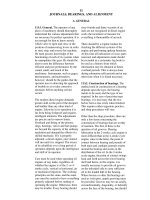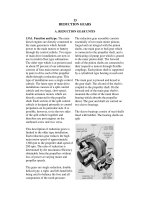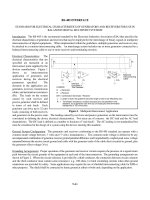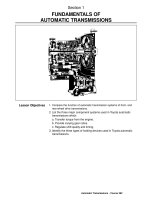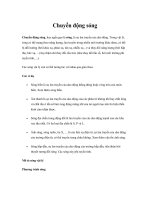Tài liệu Spread Spectrum (SS) pptx
Bạn đang xem bản rút gọn của tài liệu. Xem và tải ngay bản đầy đủ của tài liệu tại đây (267.25 KB, 19 trang )
Jan De Nayerlaan, 5
B-2860 Sint-Katelijne-Waver
Belgium
www.denayer.be
Spread Spectrum (SS)
applications
ir. J. Meel
Studiedag Spread Spectrum
6 okt. ’99
In the period of nov. 1997 - nov. 1999 a ‘Spread Spectrum’ project was worked out at the
polytechnic ‘DE NAYER instituut’. The goal of this project was the hardware/software
implementation of a Direct Sequence Spread Spectrum (CDMA) demonstrator in the 2.4 GHz
ISM band. A measurement environment (Vector Signal Analyzer, IQ-modulator, Bit Error Rate
Tester) was build out, resulting in a set of experiments based on this demonstrator. The project
results where communicated with SMO’s (Small and Medium Organisations) interested in Spread
Spectrum. These notes were used to introduce the SMO’s in the subject of Spread
Spectrum.This Spread Spectrum project was sponsered by:
Vlaams Instituut voor de bevordering van het Wetenschappelijk Technologisch onderzoek
in de industrie – (Flemisch Gouvernment)
Sirius Communications – Rotselaar - Belgium
V2 dec 99
DE NAYER (ir. J. Meel) IWT HOBU-fonds Spread Spectrum 2
CONTENTS
1. SPREAD SPECTRUM APPLICATIONS..............................................................................3
1.1 WLAN IEEE 802.11...........................................................................................................3
1.1.1 Network Topology ......................................................................................................3
1.1.2 Physical Layer (Radio Technology) ...........................................................................4
1.2 GPS (GLOBAL POSITIONING SYSTEM) .................................................................................7
1.3 IS-95.................................................................................................................................13
1.3.1 Network Architecture................................................................................................13
1.3.2 Forward Link Radio Transmission............................................................................14
1.4 W-CDMA..........................................................................................................................17
DE NAYER (ir. J. Meel) IWT HOBU-fonds Spread Spectrum 3
1. Spread Spectrum Applications
1.1 WLAN IEEE 802.11
IEEE 802.11 is the first internationally recognized standard for Wireless Local Area Networks
(WLAN), introducing the technology of mobile computing.
1.1.1 Network Topology
Ad-hoc Network
An Ad-hoc network or Independent Basic Service Set (IBSS) is a simple network where
communications are established between two or more wireless nodes or Stations (STAs) in a
given coverage area without the use of an Access Point (AP) or server. The STAs recognize
each other and communicate directly with each other on a peer-to-peer level.
STA1
STA3
STA2
IBSS
Infrastructure Network
An Infrastructure network (or client/server network) is a more flexible configuration in which each
Basic Service Set (BSS) contains an Access Point (AP). The AP forms a bridge between the
wireless and wired LAN. The STAs do not communicate on a peer-to-peer basis. Instead, all
communications between STAs or between an STA and a wired network client go through the
AP. APs are not mobile and form part of the wired network infrastructure.
The Extended Service Set (ESS) consists of a series of BSSs (each containing an AP)
connected together by means of a Distribution System (DS). Although the DS could be any type
of network (including a wireless network), it is almost invariably an Ethernet LAN. Within an ESS,
STAs can roam from one BSS to another and communicate with any mobile or fixed client in a
manner which is completely transparant in the protocol stack above the MAC sublayer. The ESS
enables coverage to extend well beyond the range of the WLAN radio.
DE NAYER (ir. J. Meel) IWT HOBU-fonds Spread Spectrum 4
1.1.2 Physical Layer (Radio Technology)
Spreading and Modulation
IEEE 802.11 defines three variations of the Physical Layer: Infrared (IR) and two RF
transmissions in the unlicensed 2.4 GHz ISM-band, requiring spread spectrum modulation:
DSSS (Direct Sequence Spread Spectrum) and FHSS (Frequency Hopping Spread Spectrum).
Only the RF transmission has significant presence in the market.
1Mbps
Spreading
d
t
pn
t
DBPSK
11 chip
Barker
RF (2.4 GHz)
11 Mcps 11 Msps
DSSS
FHSS
Spreading
S
/
P
d
t
pn
t
Q
DQPSK
11 chip
Barker
RF (2.4 GHz)
I
pn
t
f
RF
2Mbps
11 Msps
11Mcps
FW
Spreading
d
t
pn
t
FH
Modulator
PN
code
RF (2.4 GHz)
2-GFSK
Modulator
f
hi
1 Mbps 1 Msps 1 Msps
FW
Spreading
d
t
pn
t
FH
Modulator
PN
code
RF (2.4 GHz)
4-GFSK
Modulator
f
hi
2 Mbps 1 Msps 1 Msps
DSSS
The DSSS physical layer uses an 11-bit Barker sequence to spread the data before it is
transmitted. This sequence gives a processing gain of 10.4 dB, meeting the minimum
requirements of FCC 15.247 and ETS 300 328.
The 11 Mcps baseband stream is modulated onto a carrier frequency (2.4 GHz ISM band, with
11 possible channels spaced with 5 MHz) using:
• DBPSK (Differential Binary Phase Shift Keying): data rate = 1 Mbps
• DQPSK (Differential Quaternary Phase Shift Keying): data rate = 2 Mbps
FHSS
In the FHSS physical layer the information is first modulated using:
• 2-GFSK (2-level Gaussian Frequency Shift Keying): data rate = 1 Mbps
• 4-GFSK (4-level Gaussian Frequency Shift Keying): data rate = 2 Mbps
Both modulations result in a symbol rate of 1 Msps.
The carrier frequency (2.4 GHz ISM band, with 79 possible channels spaced with 1 MHz) hops
from channel to channel in a prearranged pseudo-random manner (hop pattern). There are 78
different hop patterns (subdivided in 3 sets of 26 patterns). The FCC and ETS regulations
require a minimum hop rate of 2.5 hops/s or a channel dwell time of less than 400 ms.
DE NAYER (ir. J. Meel) IWT HOBU-fonds Spread Spectrum 5
Spectrum
The spectrum of the transmitted signals determines the network packing.
f
2.4 GHz
2.4835 MHz
> 25 MHz
f
2.4 GHz
2.4835 MHz
hop (> 6 MHz)
< 400 ms dwell time
> 2.5 hops/s
f
22 MHz @ - 35 dB
f
1 MHz @ - 20 dB
channel
small
frequency
deviation
DSSS
FHSS
2GFSK = +/- 100 kHz
4GFSK = +/- 75 kHz
+/- 225 kHz
11 Msps
1 Msps
79 channels - 1 MHz step11 channels - 5 MHz step
78 hop patterns
(3 sets of 26 patterns)
DSSS
With a symbol rate of 11 Mbps the channel bandwidth of the main lobe is 22 MHz. There are 11
channels identified for DSSS systems, but there is a lot of overlap (only 5 MHz spacing). All
IEEE 802.11 DSSS compliant products utilize the same PN code. Since there is not a set of
codes available the DSSS network cannot employ CDMA. When multiple APs are located in
close proximity, it is recommended to use frequency seperations of at least 25 MHz. Therefore
the 2.4 GHz ISM band will accommodate 3 non-overlapping channels. Only 3 networks can
operate collocated.
FHSS
When the hop patterns are selected well, several APs can be located in close proximity with a
fairly low probability of collision on a given channel.
Up to 13 FHSS networks can be collocated before the interference is to high. This is based on
the probability of collisions where two of the nets choose the same one of 79 channels at the
same time. When the probability of collisions gets to high, network throughput suffers.
DE NAYER (ir. J. Meel) IWT HOBU-fonds Spread Spectrum 6
Comparison of DSSS and FHSS
DSSS FHSS
Spectral Density
Interference
Generation
+ reduced with processing gain
+ continuous spread of the Tx power
gives minimum interference
+ reduced with processing gain
- only the average Tx power is spread,
this gives less interference reduction
Transmission
+ continuous, broadband - discontinuous, narrowband
Interference
Susceptibility
+ narrowband interference in the
same channel is reduced by the PG
- narrowband interference in the same
channel is not reduced
+ narrowband interference in a different
channel has no influence
Multipath
+ rejection if the bandwith is wider
than the coherence delay of the
environment (outdoor applications)
- for a chiprate of 11 Mcps the chip
period is 91 ns, corresponding with a
wave distance of about 30 m (large
for indoor applications)
- some of the narrowband channels are
unusable
+ hopping makes transmission on
usable channels possible
Modulation
+ BPSK and QPSK are very power
efficient
- GFSK is less power efficient in
narrowband operation
Higher Data Rates
+ the data rate can be increased by
increasing the clockrate and/or the
modulation complexity (muli-level)
- a wider bandwidth is needed but not
available (it would cut the number of
channels to hop in)
Multiple Signals
- only 3 collocated networks
+ higher aggregate throughput
+ up to 13 collocated networks
- lower aggregate throughput
Synchronisation
+ self-synchronizing - many channels to search
Real Time (voice)
+ no timing constraints
- if a station is jammed, it is jammed
until the jammer goes away
- if a channel is jammed, the next
available transmission time on a clear
channel may be 400 ms away
Implementation
- complex baseband processing + simple analog limiter/discriminator
receiver
Power Consumption
- more power consumption due to
higher speed and more compex
processing
- more simple circuit
DE NAYER (ir. J. Meel) IWT HOBU-fonds Spread Spectrum 7
1.2 GPS (Global Positioning System)
GPS is a satellite navigation system, funded by and controlled by the U.S. Department of
Defense (DOD).
The GPS system consists of three building blocks: the Space Segment (SS), the User Segment
and the Control Segment (CS).
CS
(control segment)
US
(user segment)
SS
(space segment)
Space Segment (SS)
The Space Segment of the GPS system consists of the GPS satellites. These Space Vehicles
(SVs) send radio signals to the User Segment and the Control Segment.
The nominal GPS operational constellation consists of 24 satellites that orbit the earth in 12
hours. The satellite orbits have an altitude of 20.200km and an inclination of 55 degrees with
respect to the equatorial plane. There are six orbital planes (with nominally four SVs in each),
equally spaced (60 degrees apart). The satellite orbits repeat almost the same ground track once
each day (4 minutes earlier each day).
altitude
20.200 km
orbit
GPS
SS
GPS
US




